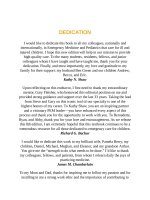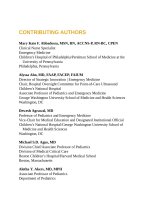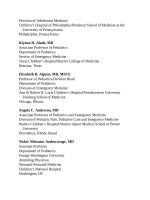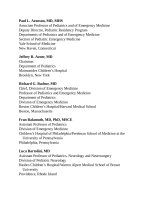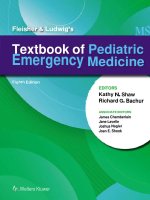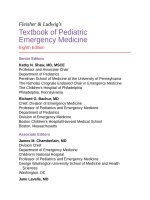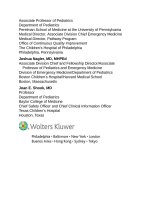Pediatric emergency medicine trisk 0330 0330
Bạn đang xem bản rút gọn của tài liệu. Xem và tải ngay bản đầy đủ của tài liệu tại đây (74.97 KB, 1 trang )
but recognized a subgroup where rapid transport was useful (epidural hematomas,
vascular compromise/open fractures, and penetrating neck/trunk injuries).
Safety of the transport personnel must also be a priority. Avoiding the use of
RW transport in bad weather is a good example of a safety decision in the
transport environment. Improvements in HEMS safety profiles were recognized
when pilots were isolated from specific patient care information for transport
requests. Instead of being informed that a critically ill child might die without
their intervention, pilots now should make “go” or “no go” decisions based solely
on weather, flight personnel, and equipment issues. If an appropriate “no go”
decision is made, this should not be questioned or countermanded by medical or
administrative personnel. If a “no go” decision is made based on weather
considerations, another mode of transport or other patient care options must be
considered. Competition between transport programs or aeromedical providers
can be a safety hazard. In efforts to gain a competitive advantage, programs (or
specific personnel) may be willing to consider circumventing weather and safety
rules. Optimal policies for safety-conscious systems include when a transport is
denied by one air service for weather-related issues, those same transports are not
offered to another air service unless it is located in a different environment that
may not be subject to the same weather issues.
Unfortunately, the HEMS industry has seen periodic increased accident and
fatality rates. Compared to ground ambulance transport (15 million annual patient
exposures), the fatal accident rate is greater for helicopter transport by
approximately 13.5 times, however in the last three decades the accident rate in
HEMS has declined by 71%. In 2006, the National Transportation Safety Board
(NTSB) critically reviewed 55 HEMS accidents and found that over half of the
fatalities could have been prevented with systematic corrective actions. This
review resulted in safety initiative recommendations, which are outlined in the
NTSB publication, Special Investigative Report on Emergency Medical Services
Operations, available at www.ntsb.gov . The following recurring safety issues
were noted: (i) Less stringent requirements for EMS operations conducted
without patients on board, (ii) lack of aviation flight risk-evaluation programs for
EMS operations, (iii) lack of consistent, comprehensive flight dispatch
procedures for EMS operations, and (iv) no requirements to use technologies such
as terrain awareness and warning systems (TAWS) to enhance EMS flight safety.
Interventions by the FAA have resulted in safety improvements, including
certification of night vision goggles (NVG) for helicopter use. Other
recommendations include TAWS, more stringent flight operation requirements,
improved preflight risk management and hazard identification, and mitigation

